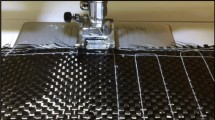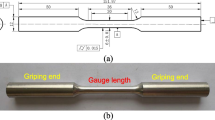Abstract
This paper deals with the fatigue behavior of cracked piezoelectric ceramics in cyclic bending under electric fields both numerically and experimentally. Fatigue tests were carried out in three-point bending with the single-edge precracked-beam specimens. The crack was created normal to the poling direction. Number of cycles to failure was measured under different electric fields. A plane strain finite element analysis was also performed, and the effect of polarization switching on the energy release rate was discussed under a high negative electric field. In addition, possible mechanisms for crack growth were discussed by scanning electron microscope examination of the fracture surface of the piezoelectric ceramics.








Similar content being viewed by others
References
Y. Shindo, in Fracture and Crack Mechanics, ed. by J. Yang. Special Topics in the Theory of Piezoelectricity (Springer, Dordrecht Heidelberg London New York, 2009), p. 81
Y. Shindo, F. Narita, M. Hirama, Dynamic fatigue of cracked piezoelectric ceramics under electromechanical loading: three-point bending test and finite element analysis. J. Mech. Mater. Struct. 4, 719 (2009)
F. Narita, Y. Shindo, F. Saito, Cyclic fatigue crack growth in three-point bending PZT ceramics under electromechanical loading. J. Am. Ceram. Soc. 90, 2517 (2007)
Y. Shindo, F. Narita, T. Matsuda, Electric field dependence of the mode I energy release rate in single-edge cracked piezoelectric ceramics: effect due to polarization switching/dielectric breakdown. Acta Mechanica. 219, 129 (2011)
J. Wang, T.-Y. Zhang, Phase field simulations of polarization switching-induced toughening in ferroelectric ceramics. Acta Mater. 55, 2465 (2007)
S. Kalyanam, C.T. Sun, Modeling the fracture behavior of piezoelectric materials using a gradual polarization switching model. Mech. Mater. 41, 520 (2009)
B.-X. Xu, D. Schrade, D. Gross, R. Mueller, Phase field simulation of domain structures in cracked ferroelectrics. Int. J. Fract. 165, 163 (2010)
S.C. Hwang, C.S. Lynch, R.M. McMeeking, Ferroelectric/ferroelastic interactions and a polarization switching model. Acta Metall. Mater. 43, 2073 (1995)
Y. Shindo, M. Yoshida, F. Narita, K. Horiguchi, Electroelastic field concentrations ahead of electrodes in multilayer piezoelectric actuators: experiment and finite element simulation. J. Mech. Phys. Solids. 52, 1109 (2004)
T. Steinkopff, Finite-element modelling of ferroic domain switching in piezoelectric ceramics. J. Euro. Ceram. Soc. 19, 1247 (1999)
F. Narita, Y. Shindo, K. Hayashi, Bending and polarization switching of piezoelectric laminated actuators under electromechanical loading. Comput. Struct. 83, 1164 (2005)
Y. Shindo, F. Narita, M. Hirama, Effect of the electrical boundary condition at the crack face on the mode I energy release rate in piezoelectric ceramics. Appl. Phys. Lett. 94, 081902 (2009)
T. Matsudaira, Y. Matsumura, S. Kitaoka, H. Awaji, Effect of microstructure on the fatigue behavior of aluminum titanate ceramics. J. Mater. Sci. 44, 1622 (2009)
Y. Zhou, Z. Sun, The compressive property and brittle-to-ductile transition of Ti3SiC2 ceramics. Mat. Res. Innovat. 3, 171 (1999)
Acknowledgments
This work was supported by the Ministry of Education, Culture, Sports, Science and Technology of Japan under the Grant-in-Aid for Scientific Research (B).
Author information
Authors and Affiliations
Corresponding author
Appendix
Appendix
For piezoelectric ceramics which exhibit symmetry of a hexagonal crystal of class 6 mm with respect to principal \(x_{1}, x_{2}\) and \(x_{3}\) axes, the constitutive relations can be written in the following form:
where
Rights and permissions
About this article
Cite this article
Shindo, Y., Sato, M. & Narita, F. Effects of electric field and poling on the fatigue of cracked piezoelectric ceramics in cyclic three-point bending. J Electroceram 31, 8–14 (2013). https://doi.org/10.1007/s10832-013-9798-8
Received:
Accepted:
Published:
Issue Date:
DOI: https://doi.org/10.1007/s10832-013-9798-8




